Recommended Sightseeing Courses in Utsunomiya City
Downtown Utsunomiya (about 4 hours on foot)
Kyu-Shinoharake-Jutaku(Former Residence of the Shinoharas) ⇒ Hizumishi no Haka (Tombs of Hizume Brothers) ⇒ Seigan-ji Temple ⇒ Oshidori-zuka (Tomb of Mandarin Ducks) ⇒ Futaara-yama Jinja (Futaara-yama Shrine) ⇒ Kirasse (Gyoza Dumpling Hall) ⇒ Matsugamine Kyokai (Matsugamine Church) ⇒ Utsunomiya Joshi Koen (Utsunomiya Castle Ruins Park) ⇒ Zengan-ji Temple ⇒ JR Utsunomiya Station
Stone Town Oya (about 3 hours on foot & by bus)
Tengu-no-nageishi(Rock of Tengu) ⇒ Heiwa Kannon (Goddess of Peace) ⇒ Oya-ji Temple ⇒ Oya Museum ⇒ Oya Spectacular Park ⇒ Stone Monument ⇒ Kyu-Oya-Kokaido (Former Oya Town Hall) ⇒ (bus) ⇒ JR Utsunomiya Station
Historic Spots in Oya (about 5 hours on foot & by bus)
Heiwa Kannon(Goddess of Peace) ⇒ Tagesan Jihoin (Tage Fudoson Temple) ⇒ Tage Joseki (Ruins of Tage Castle) ⇒ Onoguchike-Jutaku (Residence of the Onoguchis) ⇒ Yakushi Buddha Statue / Noman-ji Temple ⇒ (bus) ⇒ JR Utsunomiya Station
- Please do not hesitate to contact us if you want to visit other sight seeing spots in the Utsunomiya Area. We can tailor a custom sightseeing course according to your interests.
Around Utsunomiya City
Utsunomiya
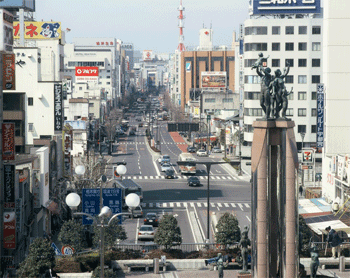
- Utsunomiya, about 100 kilometers north of Tokyo, is the capital city of Tochigi Prefecture. It is the biggest city in the northern part of the Kanto Region with a population of around 500,000.
Utsunomiya has several industrial complexes with cutting-edge industries, but at the same time it is also rich in natural beauty. There are many time-honored shrines and temples in the city as well as sightseeing spots like the Utsunomiya Castle Ruins Park.
Famous for gyoza dumplings, it is sometimes called "the City of Gyoza".
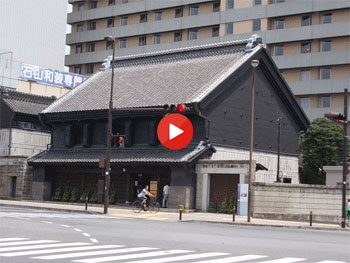
The buildings, built in 1895, belonged to the Shinohara Family, which is one of the oldest and most prominent families in Utsunomiya.
Historically, the Shinoharas, living along the Oshu Highway, brewed soy sauce and manufactured fertilizer and sold them as early as the Edo Period (i.e. at the end of the 18th century).
However, an air raid in World War II burnt down the brewery and the rice warehouse, leaving only the main house and three stone warehouses untouched.
The unique buildings, rarely seen in present day, are an excellent example of a wealthy merchant's home of the Meiji Period (1868-1912).
What gives the buildings a magnificent air is its outer walls made of black plaster and Oya-stone, the lattices of the facade which characterize a merchant's house, and the large floor space of the main house (33 square meters) which consists of two stories.
2.Iron Monument(Tettoba) / Seigan-ji Temple
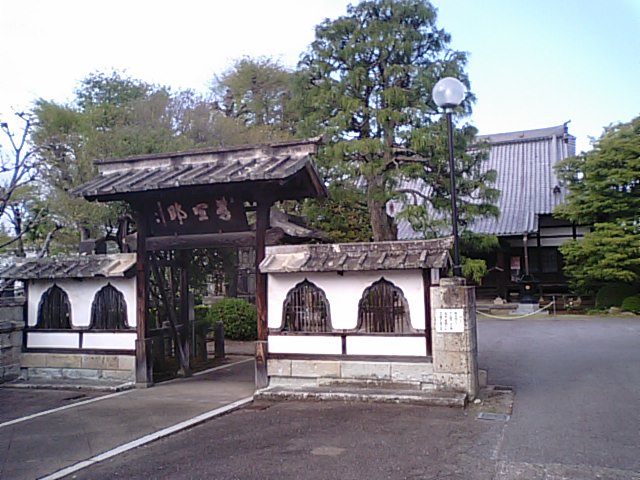
The Seiganji Temple was built by the Utsunomiya Clan in 1215(early Kamakura Period).Originally it was called “Nenbutsudo” (Hall of Prayer to Amida Buddha). About three hundred and fifty years later, in the Age of Civil Wars (Sengoku-Jidai), the Haga Clan, who was a retainer of the Utsunomiya Clan, moved the temple to the place where it is and changed its name to “Seiganji”.
The iron monument was constructed in 1312(late Kamakura Period) by Sadatsuna Utsunomiya, the eighth lord of the Utsunomiya Castle.He held a memorial service on the thirteenth anniversary of his mother’s death. On the surface are cast in relief Sanscrit characters, images of Amida Trinity, and an inscription.
It is highly valuable since there is no other iron stupa in Japan. It was damaged and broken into three parts by a rainstorm in 1849(late Edo Period)but restored in 1911. Recently, in 1996, a rust preventive treatment was applied to it, because of terrible corrosion.
3.Oshidori-zuka (Tomb of Mandarin Ducks)
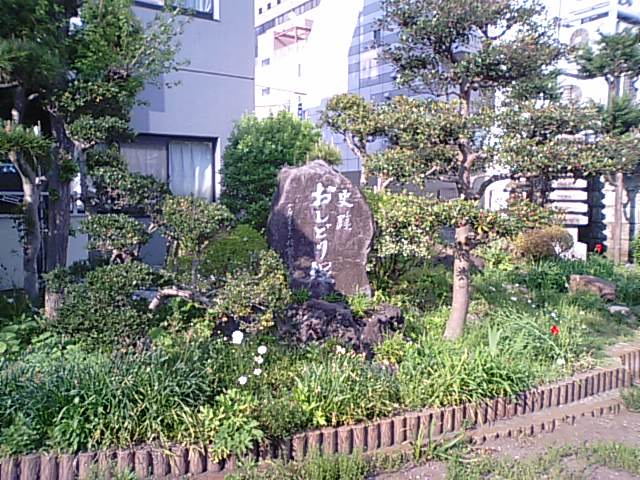
The story of Oshidori-Zuka is reported in the book “Shasekishu” written by Muju, a Buddhist monk in the Kamakura Period (1185-1333).
A hunter shot a mandarin drake in the nearby Asari River. He cut its head off and carried the prey home, leaving the head there. The next day, he shot a duck huddled in the same spot and found the drake’s head he had severed the previous day.It was cradled securely under her wings. Deeply moved by the bird’s love to her husband, he repented of his life of killing. He built a tomb for them and a stone pagoda on it, praying for the repose of the pair of birds.
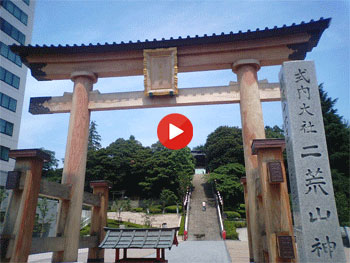
It has long been the main shrine (Ichi-no-Miya) of the region. The shrine has a long history, founded about 1,600 years ago to dedicate the spirit of Toyoki-Irihiko-no-Mikoto, founder of Utsunomiya. Utsunomiya City has developed around this shrine. According to one theory, the name "Utsunomiya" comes from "Ichi-no-Miya".
Many people visit the shrine on such occasions as New Year's Day and 3-5-7 Day (ceremonial day for children of 3, 5 and 7 years of age). They come here also when they need the help of the gods, wishing for example to pass various kinds of entrance examinations or to find a good marriage partner.
It houses an iron guardian dog and a helmet, both designated as important cultural assets. The gate and the stone step approach to the shrine are beautifully illuminated at night.
5.Gyoza Dumpling Hall (Kirasse)
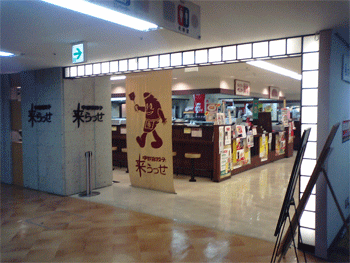
Utsunomiya-Kirasse is a complex of gyoza-dumpling restaurants run by the Utsunomiya City Gyoza Association. It moved here in April 2007. Here you can enjoy various kinds of gyoza cooked by different restaurants including Koraku, Min-min, Men-men, Satsuki and Ryumon. Takeout is also available. You can observe how gyoza-dumplings are made by professional cooks and also learn to make your original gyoza.
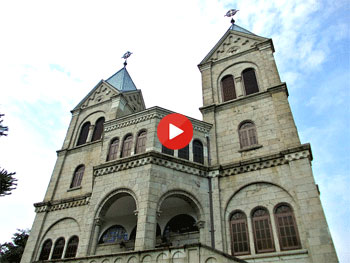
Near Tobu Utsunomiya Station there is a typical Romanesque church with beautiful twin steeples, which is generally known as the Matsugamine Church. This church is claimed to be the biggest existing Oya-stone structure in Japan.
The church building, designed by Max Hinder, a Swiss architect, was completed in 1932. And in the same year it was consecrated first in Japan.
In 1987 the Agency for Cultural Affairs certified the church as a cultural property.
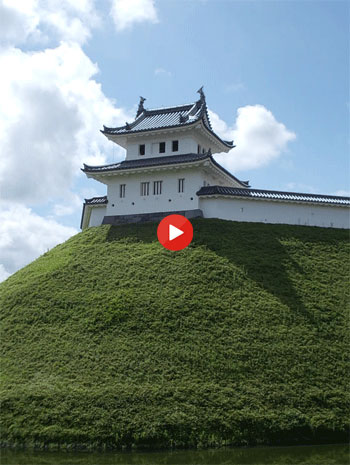
The Utsunomiya Castle is said to have been founded by Hidesato Fujiwara, a feudal lord, in 940. Since the Kamakura Period (1185-1333) , it had been the castle of the Utsunomiya Clan. Almost all the buildings of Utsunomiya Castle were burned down during the civil war in 1868, just before the Meiji Restoration.
Recently its watchtowers, walls, banks and moat were restored as "Utsunomiya Castle Ruins Park". Documents about the castle are exhibited at Seimei-kan in the park. It is now a place of recreation and relaxation for everyone. A lot of people come here on holidays for a glimpse of the Old Utsunomiya.
8.Bronze Buddha of Utsunomiya (Utsunomiya-Daibutsu) / Zengan-ji Temple
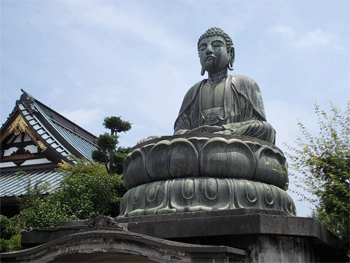
When you enter the gate of the Zenganji Temple, you see in front a sitting Buddha of bronze, 3.6 meters in height. It’s called “Three Soybeans Bronze Buddha”. The legend goes as follows:
A long time ago the chief priest of the temple had a plan to build a bronze Buddha but found difficulty collecting money for it. He consulted a wandering Buddhist monk who chanced upon the temple.
The monk took out 3 soybeans and gave them to the chief priest, suggesting he should grow and multiply them. If the people in the neighborhood helped grow them together, they could get a huge amount of beans to raise money. The priest took the advice and could finally build the Buddha after ten years.
Oya/Tage-san
Oya District is well known as the production area of Oya-stone (Oya-ishi), a kind of green tuff. Oya is located in the west of Utsunomiya. Oya-stone was formed by a volcanic eruption about 20 million years ago. It’s soft, durable and easy to work. They are used for constructing various kinds of buildings.
In Oya you can see rows of houses and streets made of Oya-stone.
A 27 meter high statue of Heiwa Kannon (Goddess of Peace) stands here and the oldest rock carvings of Buddha are in the Oyaji Temple.
The huge underground quarry space of Oya Shiryokan (Oya-stone Museum) is spectacular.
9.Rock Thrown by Tengu (Tengu-no-nageishi)
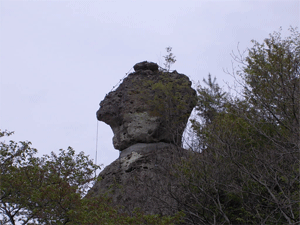
On the top of the cliff near the Oyaji Temple you see a huge rock of Oya-stone. It’s called Tengu-no-Nageishi (rock thrown by a tengu). The legend says that a tengu (long-nosed Japanese goblin) who lived in Mt. Tomuro near Oya, wishing to show off his supernatural power, took one stone after another and flung them in every direction. One of them came to rest on the cliff of Oya, which people later called Tengu-no-Nageishi. The rock is fixed with wires for safety reasons.
10.Stone Statue of Goddess of Peace (Heiwa Kannon)
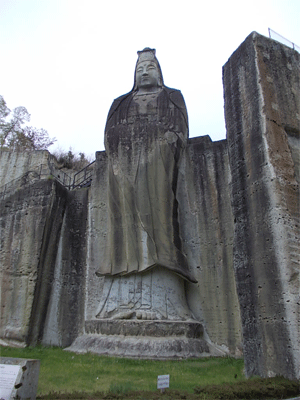
This huge kannon is 27 meters high and was carved on the wall of Oya-stone.
The statue was cut out by hand from 1948 to 1954. It was built in commemoration of those killed in World War II and is called Kannon of Peace.
The lookout from the top of the statue commands a bird’s-eye view of the whole Oya district.
11.Oyaji Temple
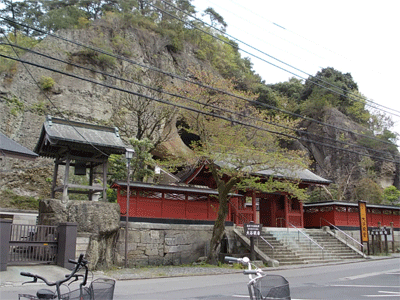
The Oyaji Temple, carved into a natural cave, was built by the high priest Kobo-Daishi in 810.
The 4-meter-high Senju-sengen Kannon (Thousand-armed and Thousand-eyed Kannon), carved on the surface of a huge cave, is the main Buddha image of the temple.
The legend says, it was carved by Kobo-Daishi in one night. It’s the oldest rock-carved Buddha in Japan.
Besides the kannon which was carved in the early Heian Period, a Shaka-Buddha Trinity (in the late Heian Period), Yakushi-Buddha Trinity (in the early Heian Period), and Amida-Buddha Trinity (in the Kamakura Period) are also carved on the cave wall.
The bronze bell (1695), the bronze lantern (1716), and the bronze waniguchi (a kind of gong, which means “Crocodile Jaw”) (1667) of the temple are also cultural assets of the city and they are worth seeing.
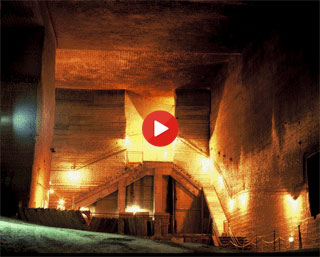
This museum exhibits the history of Oya-stone.
The extensive space under the museum building, once used as a quarry, is 20,000 square meters. The deepest point is 60 meters and the annual average temperature is 13 degrees Celsius.
The magnificent, fantastic and mysterious atmosphere, which reminds us of a catacomb in Rome, is breathtaking.
13.Oya Cliff Panorama Park (Oya Keikan-Koen)
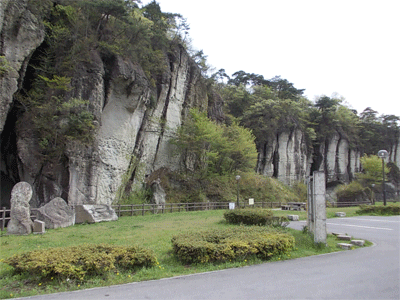
The park commands a whole fantastic view of the Oya-stone cliff. The murmur of the brook and the breeze coming over the surface of the river are enchanting. People visit here to take a rest on the lawn.
14.Stone Monument
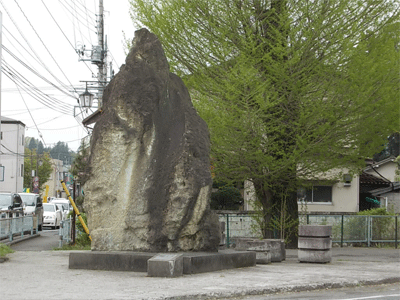
Driving from JR Utsunomiya Station westward along Route 119 (Ekimae-o-dori) for about 20 minutes, you find a rock monument of Oya-stone, which marks the entrance to Oya District.
If you are going to visit Oya Heiwa Kannon or the Oyaji Temple, turn right at the monument.
15.Former Oya Town Hall (Kyu-Oya-Kokaido)
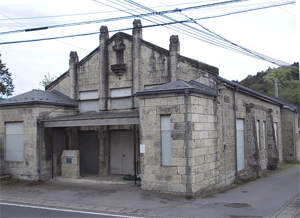
Kyu-Oya-Kokaido is an old municipal hall of Shiroyama Village built in 1929 to commemorate the coronation of the Emperor Showa. After serving as a municipal hall, town hall, playhouse, theater, and movie house, it now is used as a storehouse.
The building is a fine example of Oya-stone structure and is designated as a national tangible cultural property.
16.Statue of Fudo-Myo-o of Tagesan / Tagesan Jihoin Temple
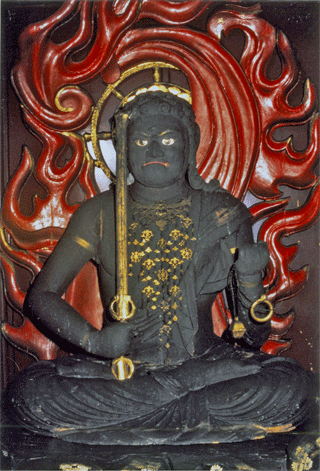
The oldest temple in the area had long prospered as the invocation temple for the Utsunomiya clans who ruled here. It’s dedicated to Fudo-Myo-o, one of the guardian gods of Buddhism, who is believed to possess the power of preventing fire and of bringing business prosperity.
The shops on the streets sell baked skewered taro potatoes and frog mascots of Oya-stone.
17.Ruins of Tage Castle (Tage Joseki)
This is a ruin of the castle which is said to have been used by the Utsunomiya Clan to obstruct an assault of the Hojo Clan. The castle covered a wide area of Mt. Tage with mounds and moats scattered all over.
There are now three easy trekking courses to the top of Mt. Tage.
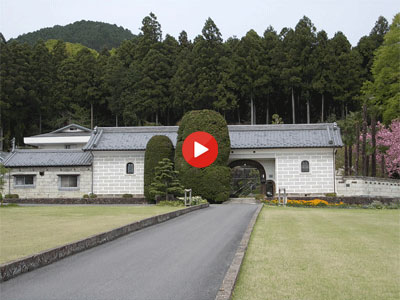
The Onoguchis are one of the prominent families of Oya Area and most of their buildings are made of Oya-stone. It is to be noted, that they have different styles of buildings from different ages in the same grounds partly adopting Western architectural styles. Some of them are designated as national tangible cultural assets.
19.Yakushi Buddha Statue / Noman-ji Temple
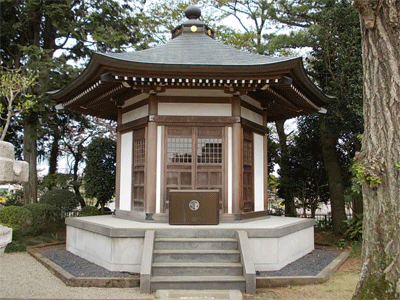
This statue of Yakushi-Buddha is made of one piece of torreya wood. It dates back to the middle of the Heian Period and is the oldest Buddha statue in Utsunomiya City. The statue was long enshrined in the Hashita Yakushido Temple and moved here in 1994 after being completely repaired and restored-Yakushi-do and moved here 1994 after being completely repaired and restored.


















